Growing tomatoes in a greenhouse: step-by-step instructions for beginner gardeners and tips from experienced colleagues
What can they make from tomatoes? Juice, salads, pasta - the list of dishes is endless. Tomatoes also have excellent medicinal properties: they have a healing and rejuvenating effect. Tomatoes are widely used in cosmetology and folk medicine.
In order to grow a rich harvest of tomatoes, you need to have special knowledge and know some secrets. The choice of seeds, soil, natural conditions - all this affects what the harvest will be like. In this article we will talk about growing tomatoes in a greenhouse and share some secrets.
Why experienced gardeners love growing tomatoes in a greenhouse so much
Tomato is a heat-loving crop. Without a greenhouse, getting a good harvest will not be so easy. This is why experienced gardeners prefer to grow tomatoes in greenhouses. They create favorable conditions for vegetables - they protect from bad weather and pests.
Varieties and types of tomatoes for the greenhouse
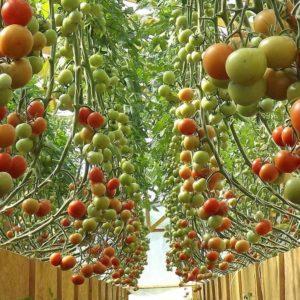 What kind of tomatoes should I plant? You need to know that all varieties of culture are divided into two types: determinant and indeterminate.
What kind of tomatoes should I plant? You need to know that all varieties of culture are divided into two types: determinant and indeterminate.
To the first These include tomatoes that grow to a certain size. This species is great for small greenhouses. To the second These include tomatoes in which the growth of the main stem is not limited.
Let's look at the varieties of determinate tomatoes and determine which ones are best grown in a greenhouse:
- "Spring of the North" and "Doll" - sweet and large tomatoes, pink variety.They have dense flesh and tolerate transportation well. Not sensitive to diseases, adapt to adverse weather conditions.
- "Openwork". It reaches a height of 60-90 cm. It has a slightly flattened shape. The fruit is fleshy, with a dense skin. It is characterized by high yield and high taste, which is why the variety is so popular among gardeners. Disadvantages include difficulties in caring for the plant and a high need for special fertilizers.
- "Bourgeois." It tolerates lack of moisture well and has a high tolerance to fungal diseases and insects. Disadvantages include fragility of branches and low yield.
For indeterminate varieties, the following should be distinguished:
- "Abakan pink" - beautiful and sugary fruits. Among the advantages, early ripeness should be especially highlighted.
- "Watercolor" - elongated vegetables. Excellent for homemade preparations, they are unpretentious in nature. The weight of one tomato can reach 120 g.
- "Balcony Miracle" - has a rich red color. It is valued not only among gardeners, but also among lovers of beautiful garden decorations.
- "King Orange" - has a loose structure and ripens quickly in a greenhouse.
- "Bull's Heart" - one of the most famous species. It has large red-pink fruits.
Read also: top 25 sweetest tomato varieties.
How to grow tomatoes in a greenhouse
As you know, growing is a labor-intensive but enjoyable process. Let us look in detail at what needs to be done to reap a good harvest of tomatoes in a greenhouse, even for novice gardeners.
Preparing the soil in the greenhouse
We advise you to change the soil in the greenhouse before planting the crop. - treat it with a hot solution of copper sulfate. The beds should be prepared 5-7 days before planting.Height - about 30 cm, width - about 80 cm. Good loosening and drainage will help in the fight for the harvest.
Passages 60-70 cm wide should be left between the beds.
Important! Do not forget to maintain moderate soil moisture. If you use peat, you need to add humus, sawdust and sand to it.
Preparing to sow seeds
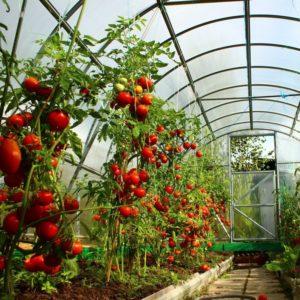 Sowing dates vary depending on the regions of our country. If you collected the seeds yourself, they must be treated before planting. Place them in small gauze bags and then place them in a solution of potassium permanganate for 15 minutes.
Sowing dates vary depending on the regions of our country. If you collected the seeds yourself, they must be treated before planting. Place them in small gauze bags and then place them in a solution of potassium permanganate for 15 minutes.
Afterwards, the bags must be rinsed under running warm water. If you are using ready-made seed, it is still better to soak it in water.
Then put the seeds in damp gauze for 20 hours. At this time, take plastic containers and pour boiling water over them. Make holes through which excess moisture will escape.
Prepare nutrient soil. It is made from coarse sand, sawdust, turf soil, compost and peat. Place drainage at the bottom of each container.
How to grow seedlings
Containers with seedlings are placed in a warm and bright place. Remember that tomatoes are heat-loving plants; the air temperature should be at least 25 degrees. To make seedlings appear faster, cover each container with film. After the first shoots, remove it.
For seven days after this, reduce the temperature to 16 degrees. It is necessary to harden the seeds so that in case of cold weather they do not freeze. Then the temperature is raised again to 20 degrees. You need to follow the regime until the second leaves appear. This usually happens a month after the emergence of seedlings.
Turn the containers over to the window every day to prevent the seedlings from being pulled to one side. It is advisable to place containers not on the windowsill, but on a stand. When the seedlings are ready for planting, their size reaches 15-35 cm.
Picking and hardening
Picking (transplanting plants into separate pots) is necessary so that the root system of the future vegetable becomes stronger. This must be done carefully so as not to damage the fragile stems. The plant is placed in a 0.5 cm depression and covered with soil. Then water it with plenty of water.
Before planting in the ground, plants must be hardened off. If this is not done, the tomatoes may die. Hardened seedlings have a more powerful root system and thick stems. In addition, sugar accumulates in the plant, and a layer of epidermis forms on the stems and leaves. Let's look at how you can harden seedlings in a greenhouse.
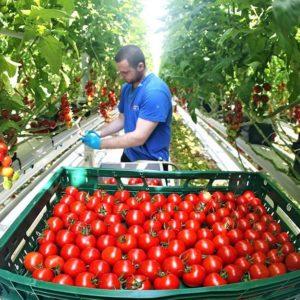 The temperature and humidity levels in it should be close to open ground conditions. To harden off the plants, simply open the greenhouse during the day. To harden the root system of tomato bushes, heavy watering should be reduced. It is recommended to water the plant moderately with solutions of phosphorus and potassium fertilizers.
The temperature and humidity levels in it should be close to open ground conditions. To harden off the plants, simply open the greenhouse during the day. To harden the root system of tomato bushes, heavy watering should be reduced. It is recommended to water the plant moderately with solutions of phosphorus and potassium fertilizers.
A week before planting in the ground, watering should be stopped altogether. This will help develop the cold resistance of tomatoes, which in the future will not lead to their death if the temperature in the soil drops sharply.
Hardening of tomatoes begins one and a half to two weeks before planting in the ground. You should pay attention to the following nuances:
- Temperature. It must be stable throughout the entire hardening period. The maximum permissible low temperature when hardening seedlings is 8 degrees.
- Light. Direct sunlight can cause leaf burns. Therefore, hardening begins in darkened areas. The plant should be accustomed to the sun gradually.
- A draft can be dangerous for seedlings. He needs to be excluded.
Planting tomato seedlings in greenhouses
When transplanting into soil, it is better to transfer the plant along with a lump of earth. Try to plant the tomato as deep into the ground as possible. But if your seedlings are taller than expected, it is not advisable to deepen them. This is a common mistake gardeners make.
Plant tomatoes in one line or in a checkerboard pattern. It is better that there are no large distances between the bushes. Recommended width: 60 cm.
Aftercare
After the seedlings are prepared, the most important stages begin - tying, pinching, watering and feeding. Let's take a closer look at what each of them includes.
Tying and pinching tomatoes in a greenhouse
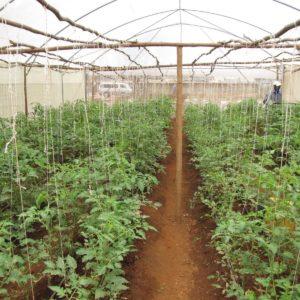 Tying up - this is the attachment of branches and stems to a support. It is done using rags, ropes, and plastic loops. In some cases, the plant should be tied in several places at once.
Tying up - this is the attachment of branches and stems to a support. It is done using rags, ropes, and plastic loops. In some cases, the plant should be tied in several places at once.
Don't tie it too tight. The procedure is necessary to prevent moisture from getting on the stems and leaves. And so that the branches do not break. Plus, tying makes caring for tomatoes and harvesting easier.
Stepsoning (removing lateral shoots on a tomato stem) is necessary to increase yield and avoid many problems. The shoots need nutrition, so if they are not removed in time, they will take away some of the vitamins and moisture that the fruit needs.
Watering and fertilizing tomatoes
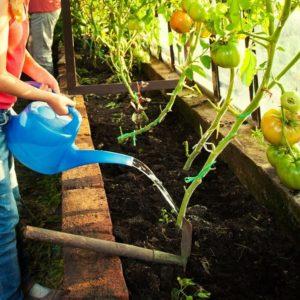 Greenhouse tomatoes do not like a lot of water. If you water too much, your vegetables may get sick. Before flowering begins, you should water them twice a week. One bush requires 2-3 liters of water.
Greenhouse tomatoes do not like a lot of water. If you water too much, your vegetables may get sick. Before flowering begins, you should water them twice a week. One bush requires 2-3 liters of water.
During flowering, the volume of water should be increased to 5 liters per bush. When the first fruits appear, they need to be watered 2 times a week. As soon as the first red fruits ripen, you can water the bushes once a week.
Excessive watering can cause cracking of the fruits and rotting of the roots.
There are many ways to feed tomatoes. This can be done both with the help of folk remedies and with the help of professional fertilizers. To the first includes iodine solution, ash solution, yeast, chicken droppings.
Nitrogen and phosphorus fertilizers, “Monophosphate”, “Solution”, “Calcium nitrate” are widely used. Their advantage is that they eliminate the need to independently create mixtures of chemicals and fertilizers.
Harvesting and storage
You can harvest both red and green tomatoes. If you pick vegetables with stalks, you should place them with their noses down. It is best to store vegetables in a dry place, preferably in cardboard or plastic boxes.
Cover the top of the tomatoes with thick cloth or burlap. The shelf life of ripe red tomatoes is 4 days, pink - 5 days, brown - 7 days. Green tomatoes are stored at room temperature for three weeks, gradually ripening.
Possible pests and their control
If tomatoes were not plagued by diseases, the growing process would be more enjoyable and less troublesome. However, they have not yet come up with a medicine that would rid the culture of various diseases.
Diseases of greenhouse tomatoes and methods of treatment
The most common diseases include:
- Late blight (plant fungus). It usually occurs due to high humidity. Signs of late blight include brown spots on the leaves, dry and curled leaves. As a treatment, gardeners advise using whey. It is also appropriate to use professional medicines - “Barrier”, “Barrier”.
- Mosaic - appears mainly due to contaminated soil or low-quality seeds. The leaves have light and dark green spots that look like a mosaic pattern. When this disease is detected, it is best to remove the bush, otherwise the mosaic can quickly spread to other bushes.
- White plaque is a rot that affects different parts of the tomato. There are root, apical, gray and brown rot. It is easy to recognize - the white fluff cannot be confused with other lesions. Gray rot develops due to poor ventilation, while root rot is a consequence of unfavorable soil. Brown and blossom-end rot appears due to low-quality fertilizers. White plaque should be treated with garlic infusion or wood ash powder.
- Macrosporiasis. Also characterized by brown elongated spots on the bush. Appears due to poor ventilation and high humidity. It develops most intensively at low temperatures. It is recommended to remove the entire affected bush.
What other problems might arise?
In addition to diseases, a number of other reasons can affect the quality of the crop. Let's look at how to deal with problems that arise during the growing process.
Why do tomatoes crack in a greenhouse?
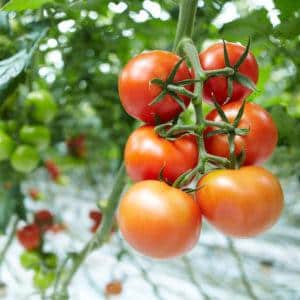 The main reason - violation of the plant watering schedule. Excessive fertilization with nitrogen-containing substances can also have an effect. Often cracks appear because the delicate fruit reacts to changes in soil moisture in the greenhouse.Because of this, not only the appearance of the tomatoes deteriorates, but also their content.
The main reason - violation of the plant watering schedule. Excessive fertilization with nitrogen-containing substances can also have an effect. Often cracks appear because the delicate fruit reacts to changes in soil moisture in the greenhouse.Because of this, not only the appearance of the tomatoes deteriorates, but also their content.
Cracks can become susceptible to fungus or other infections. To avoid this, you should create a detailed watering schedule and not deviate from it.
Important! Choose varieties that are least susceptible to fruit cracking. For example, “Beautiful Lady”, “Podmoskovny”, “Diva”.
If fruits do not grow on the second and subsequent clusters
The reasons for this phenomenon may be poor soil or low-quality fertilizers. In this case, gardeners advise treating the bush with Fitosporin-M. The product is used to strengthen fruits and accelerate growth.
Another good way to eliminate the problem is to fertilize the soil with ordinary ash.
Conclusion
Now you know how to grow tomatoes in a greenhouse, even if your gardening level is still “beginner”. The most important thing in this process is compliance with all necessary rules.
Be careful when choosing a variety, planting seedlings, and fertilizing the soil. Remember that tomatoes do not like a lot of water, follow the watering schedule. At the first symptoms of disease, treat the bush with folk remedies or professional preparations. Treat the plant with love, and then it will delight you with a rich harvest.